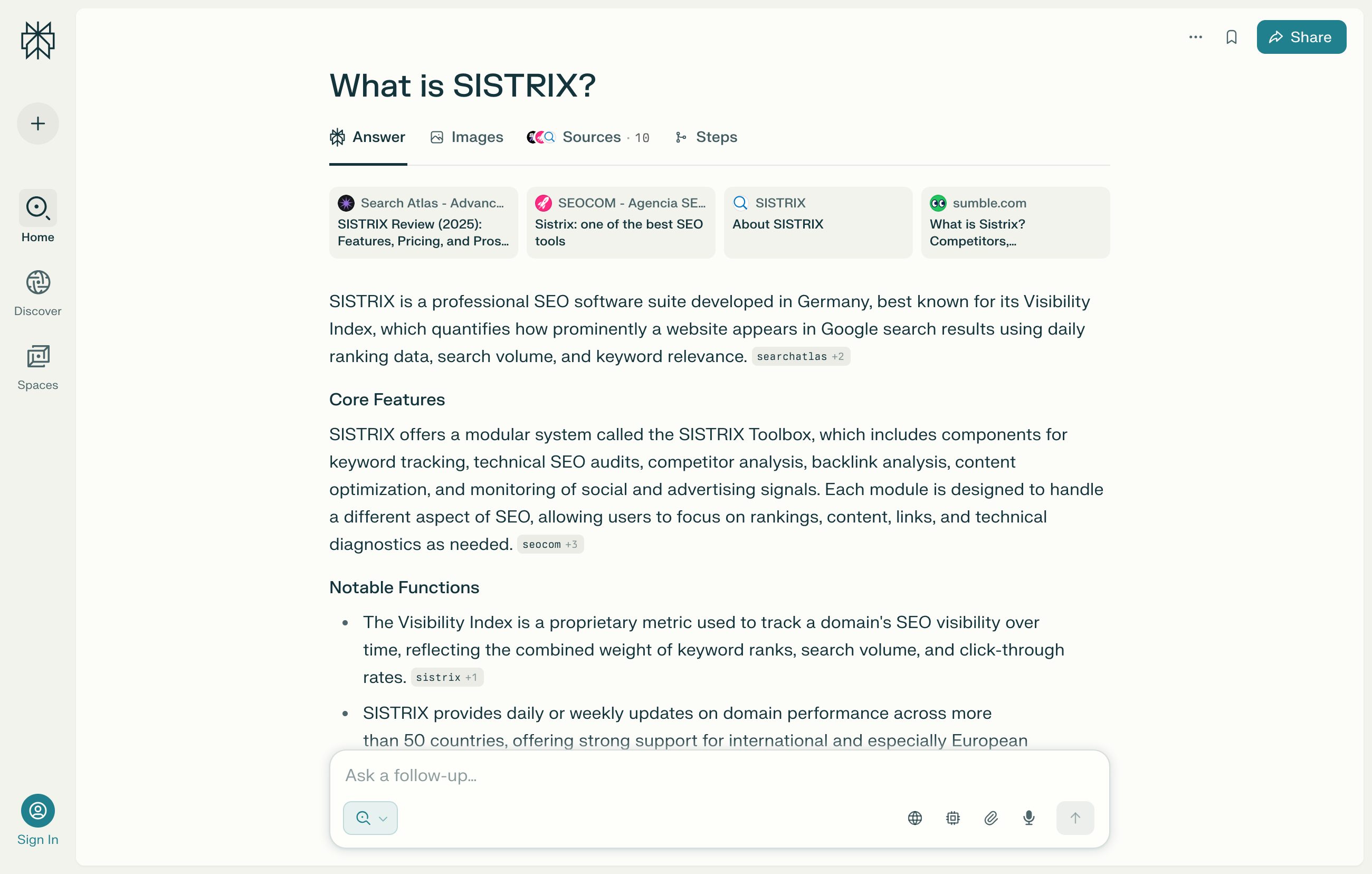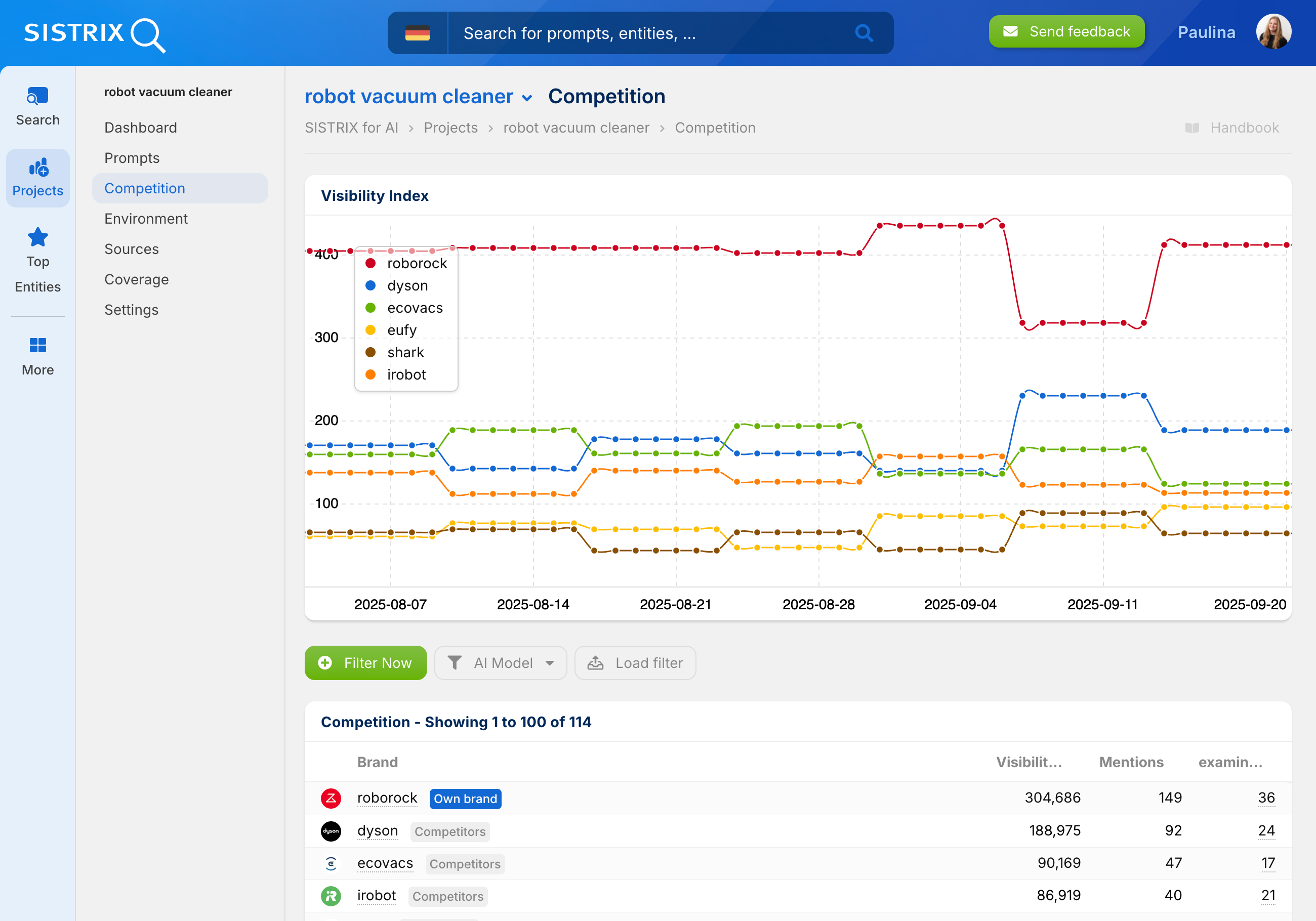The way in which we search on the internet is currently changing rapidly, thanks to new AI search machines. Perplexity AI no longer provides conventional result lists but fully phrased responses. Current web content is combined with Large Language Models, that can formulate own texts based on the given knowledge. For users, these responses are quick and convenient, but not always correct. For SEOs this means that many of the familiar tools and values are no longer viable and new tools are needed.
What is Perplexity AI?

Perplexity AI was founded in 2022 by Aravind Srinivas, Denis Yarats, Johnny Ho and Andy Konwinski in San Francisco and has transformed into one of the most well-known providers in the area of AI search. The company uses multiple Large Language Models (LLMs) such as GPT-5, Claude or Gemini and accesses the Bing Index to find current information.
Difference to conventional search engines:
- Responses instead of link list – users see a fully phrased response with integrated quotes.
- Capable of dialogue – follow-up questions are possible without losing context.
- Multilingual – among others: German, English, French, Spanish.
The result is a search that seems more up-to-date than pure LLM responses but simultaneously less stable than conventional search results.
How the search works
Perplexity combines two components:
- Webindex – delivers relevant websites for your request.
- LLM processing – summarises the content and formulates a response in natural language.
Since both components are dynamic, the results will vary widely. Even small changes in the web or a different interpretation by the model can alter the response completely. For SEO this means: the positioning in Perplexity is more volatile than with Google or Bing and thus less predictable.
SEO Issues
Perplexity is challenging for multiple reasons:
- No conventional rankings: Visibility is measured by the source quoted in the response, if there is one.
- High volatility: The results can vary day by day.
- Reduced control: Self-used content won’t always appear as a quoted source.
- Liability for making mistakes: Sources can be incomplete or wrong.
Due to these reasons, a change in understanding about the measurements of successes or new metrics that may replace conventional SERP positions is required.
Measuring Visibility with SISTRIX
The AI Chatbot analyses is currently still in the beta phase. Within the beta, you can find an area called “Projects”, where you can supervise the results from systems like ChatGPT Search or Perplexity.
The relevant search requests (prompts) for the analysis are compiled and regularly automatically executed. The responses the system gives are collected, evaluated and simply formatted. This way, you can see which domains are named, if a brand is mentioned, which competitors are cited and which topics dominate.
With these means you can retrace how present a website is within the new search systems. The analyses orients itself using the principle of the conventional search and shows for which questions a domain is named, in which context it appears and where there is still potential for optimisation.

The analysis is currently available as a beta version and is constantly being expanded. If you want to gain early insights, you can sign up to gain access. To be able to sign up, you need to have an active SISTRIX account. If you just want to try out SISTRIX first, you can sign up for a 14 day test account and start immediately.
Strategies for Optimisation
The Visibility in Perplexity can be improved specifically with conventional SEO methods.
Important, but definitely not new approaches are:
- Optimising content: Content that includes clear facts, brand names and a clean structure are cited more often.
- Strengthening of the technical base: Since Perplexity uses the Bing Index, a good indexing there is really helpful. Structured data aids with the recognition of entities.
- Use of monitoring: Regular analyses with SISTRIX show, for which topics a brand is named and where you still have hidden potentials.
A special feature: With Perplexity, it is often not enough to be visible for a specific keyword. The key is to be seen as a trustworthy source for relevant questions.
Market positioning and development
Allegedly, Perplexity is growing rapidly. In May 2025, the platform has processed about 30 million requests per day, which is a monthly development of over 20 percent, according to their own statements. The company strategically positions itself as an alternative to Google’s AI Overviews and uses unconventional ways to do so. The acquisition offer for Google Chrome in the summer 2025 shows how aggressively Perplexity is trying to secure market shares. However, such announcements are intentionally pushed as well, to secure investors and should be taken with a pinch of salt.
Apart from the search function, Perplexity is also extending more areas, such as a shopping hub, financial functions and their own browser. Simultaneously, they are running a partner program to further integrate publishers.
Scientific situation and business model
Perplexity AI is in a phase of rapid growth, but, like many other young technological companies, not yet profitable. Since the foundation in 2022, the company has closed multiple large financing rounds. The investors include, among others, Jeff Bezos, Tobias Lütke, Nat Friedman, Nvidia and Databricks. The evaluation grew up to 18 billion US-dollars within a few years.
Their business model is currently based on a freemium approach. The base version is free and offers the core functions of the AI search. Additional functions – such as an extended model selection, API access or internal data search – are part of the paid-content Pro Tariff. For businesses, there is an Enterprise offer with a higher range of functions and larger contingencies. Perplexity gains additional income via partnerships, like the cooperation with Amazon and Shopify for their content hub, or the publisher program that includes a share of the turnover.
Long-term, the company runs int the challenge of covering their high operating costs for the usage of multiple AI models and the access of current web data with stable sales. Given the strong competition in the area of AI search it remains to be seen whether the current model will suffice to legitimate the ambitious evaluation.
Controversies and risks
Critics are denouncing, that within Perplexity, there is presently no discernibly clear technological delineation or a robust long-term business model. Instead of a decisive product strategy they are supposedly publishing new functions and prototypes without solving the architectural problems of the AI technology these are based on. This includes specifically that the language models process the instructions and user input in the same text and cannot clearly distinguish between the two. This is a weakness that has been known for years, that allows so-called prompt injection attacks.
Additionally, the recurring high-publicity announcements of large acquisition plans – such as offers for TikTok or Google Chrome – are interpreted by some observers as a PR strategy to generate attention and to attract potential investors. This method calls into question if Perplexity is pursuing a long-term sustainable strategic direction or if they are primarily hoping to satisfy the high expectations they raised through costly investments short-term.
Multiple large media companies – among others the BBC, Dow Jones and the New York Times – are accusing the business of using or citing content without permission. Especially controversial: the allegation that Perplexity and its connected crawler are bypassing the robots exclusion standard. Investigations by Wired and Cloudflare show, that hidden IPs are used in part to gain access to locked content anyway.
For publishers, this is a two-fold risk: on one hand, content is potentially being used without traffic flowing back, on the other is the attribution not always correct or complete. Additionally, there is a risk that faulty or out-of-date information is spread further through the AI, which can tarnish the reputation of a brand.
Looking ahead
Perplexity is part of a fundamental change in web search. AI-supported answers will establish themselves within the next couple of years and the competition between Google, OpenAI, Perplexity and other vendors will intensify. For SEOs this means: building and measuring early visibility in these systems. With tools like the SISTRIX AI/Chatbot Tool you can easily determine and expand your own position before your competition does so.
Test SISTRIX for Free
- Free 14-day test account
- Non-binding. No termination necessary
- Personalised on-boarding with experts